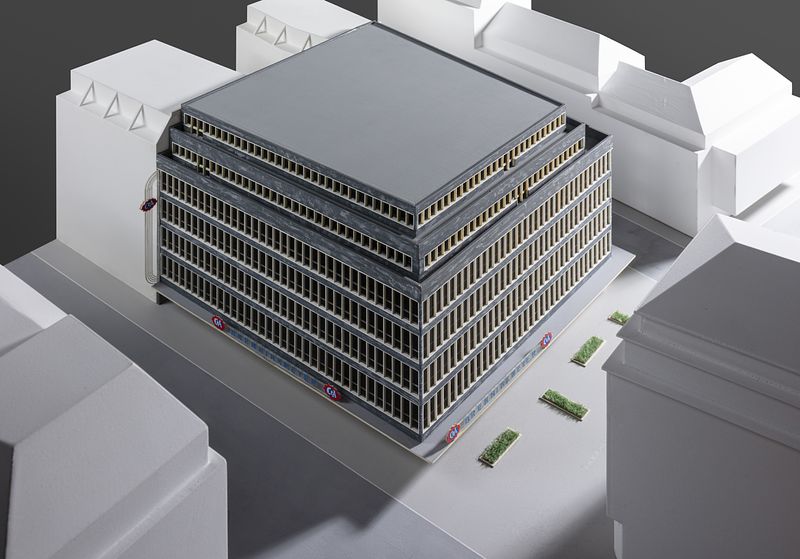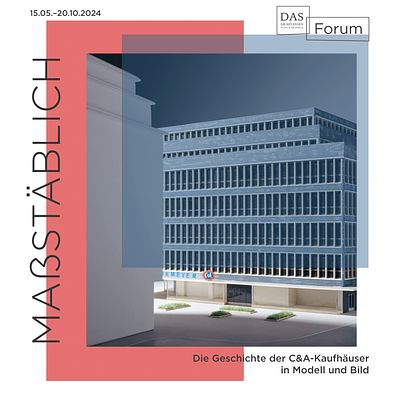TRUE TO SCALE
The History of C&A Stores in Model and Image
Press release
TRUE TO SCALE. The History of C&A Stores in Model and Image
DAS FORUM | May 15–October 20, 2024
Architectural models help to convince or even inspire clients, users, tenants and—last but not least—the public. They promote a design idea, create atmosphere and can convey complicated contexts in a clear and tangible way. The Draiflessen Collection shows numerous architectural models of C&A department stores in Germany, which give interested parties a special impression of how the architecture of C&A department stores has changed over the decades.
Fascinating miniature worlds
"The exhibition tells many stories about the buildings that have shaped German city centers for generations," explains curator Dr. Julia Cwojdzinski. "The architectural models are particularly fascinating as miniature worlds with their unique character. While they were originally a means of visualizing a possible, built future, we are now presenting them as representatives and historical testimonies to a state of construction that no longer exists in part. The architectural model is far more than a mere working tool—it is both a blueprint for the future and an artifact of times past."
Living history of the C&A department stores
There are around one hundred architectural models in the Draiflessen Collection. Most of them show C&A department stores and were largely created by the Nattler architectural office in Essen, formerly E. A. Gärtner/R. Stiens. In the course of the decades-long collaboration between C&A and the Essen office, over 170 department stores have been designed and built since the 1950s, some of which have already been converted or demolished. The exhibition TRUE TO SCALE shows around 30 architectural models from the existing collection, of which the buildings in Berlin, Hamburg, Essen, Celle and Frankfurt am Main are examined in more detail. Historical photographs of the first houses, which were built before the Second World War, provide an introduction to the history. This is juxtaposed with the most recent model from the collection, the Alea 101 complex by Sauerbruch Hutton, which was built on the site where the so-called C&A flagship store in Berlin's Königstraße once stood. The other four models date from the 1970s to the 1990s and were designed by Ric Stiens. The architect uses a media station to tell the story of the buildings, making it particularly tangible. Numerous historical motifs from the Draiflessen Collection archive complement the exhibition. A group presentation of other interesting models of completed C&A department stores is accompanied by current images by photographer HG Esch.
Continuity in cooperation
On January 1, 1841, the brothers Clemens and August Brenninkmeijer laid the foundations for the company C&A Brenninkmeijer in Sneek, the Netherlands, which is still active internationally today. At the end of the 19th century, the company expanded under the sons into the major Dutch cities with several branches. Finally, in 1911, the first branch opened in Germany on Königstrasse in Berlin—the center of ready-to-wear production.
The continuity of the successful collaboration between C&A Brenninkmeijer and today's architectural firm Nattler began in the early 20th century with the architect Sepp Kaiser (1872—1936), who was responsible for the first 20 or so department stores in Germany. In the 1930s, Kaiser handed over the management of the Berlin architectural office to his son-in-law Karl Fezer (1900—1984), who in turn later appointed the architect Ernst August Gärtner (1905—1983) as head of the office. From 1948, Gärtner, now based in Essen (Ruhr), resumed work for C&A. Together with Ric Stiens (*1930)—but especially under his later sole management—numerous other new buildings and conversions are created, which are continued from 1994 under the name Nattler Architekten.
_Draiflessen%20Collection_Architekturmodell_C&A_Hamburg_um%201970_Foto_HGEsch_2023.jpg?locale=nl)

OP SCHAAL. De geschiedenis van de C&A-winkels in model en beeld
_Draiflessen%20Collection_Stammhaus%20Berlin_um%201927.png?locale=nl)
C&A Stammhaus Berlin, um 1927
_Draiflessen%20Collection_Architekturmodell_Berlin_Alea%20101_um%202012_Foto_HGEsch_2023.jpg?locale=nl)
Architekturmodell Berlin, Alea 101, Sauerbruch Hutton, um 2012
_Draiflessen%20Collection_Architekturmodell_C&A_Essen_um%201999_Foto_HGEsch_2023.jpg?locale=nl)
Architekturmodell C&A Essen, um 1999
_Draiflessen%20Collection_Architekturmodell_C&A_Hamburg_um%201970_Foto_HGEsch_2023.jpg?locale=nl)
Architekturmodell C&A Hamburg, um 1970
Fotografie C&A Hamburg, 1985
_Draiflessen%20Collection_Architekturmodell_C&A_Celle_um%201980_Foto_HGEsch_2023.jpg?locale=nl)
Architekturmodell, C&A Celle, um 1980
_Draiflessen%20Collection_Architekturmodell_Detail_C&A_Essen_um%201999_Foto_HGEsch_2023.jpg?locale=nl)
Architekturmodell (Detail) C&A Essen, um 1999
_Draiflessen%20Collection_Architekturmodell_D%C3%BCsseldorf_um%201989_Foto_HGEsch_2023.jpg?locale=nl)
Architekturmodell C&A Düsseldorf, um 1989
_Draiflessen%20Collection_Architekturmodell%20C&A%20Pforzheim%20um%201991_Foto_HGEsch_2024.jpg?locale=nl)
Architekturmodell, C&A Pforzheim, um 1991
_Draiflessen%20Collection_Architekturmodell_C&A_Essen_um%201980_Foto_HGEsch_2023.jpg?locale=nl)
Architekturmodell, C&A Essen, um 1980
_Draiflessen%20Collection_Architekturmodell%20C&A%20Frankfurt%20um%201988_Foto_HGEsch_2024_2.jpg?locale=nl)
Architekturmodell, C&A Frankfurt, um 1988
_Draiflessen%20Collection_Architekturmodell%20C&A%20Stuttgart%20um%201991_Foto_HGEsch_2024.jpg?locale=nl)
Architekturmodell, C&A Stuttgart, um 1991
_Draiflessen%20Collection_Architekturmodell%20C&A%20Berlin%20Steglitz%20um%201986_Foto_HGEsch_2024.jpg?locale=nl)
Architekturmodell, Berlin Steglitz, EHRICHarchitekten, um 2010